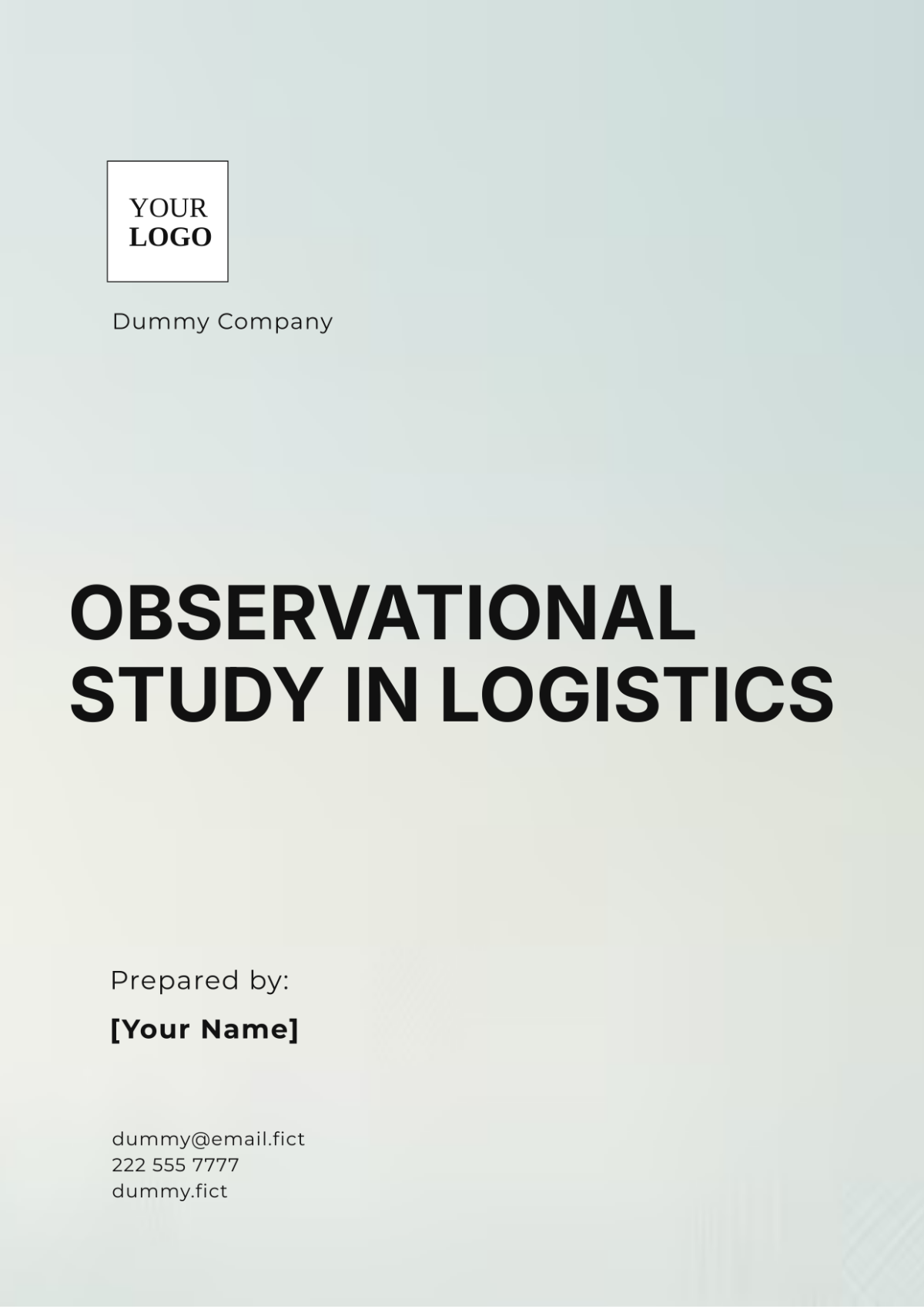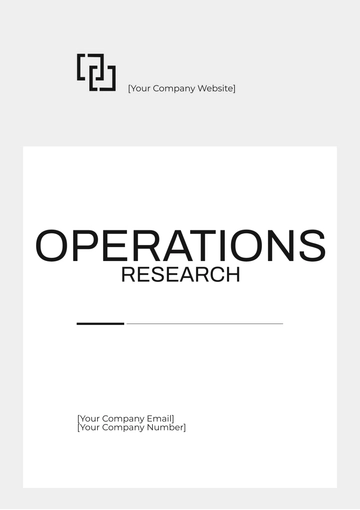Free Observational Study in Logistics

Prepared By: [Your Name]
Introduction
Logistics plays a pivotal role in the movement, storage, and flow of goods, services, and information within the modern supply chain. It encompasses various processes, including transportation, warehousing, inventory management, and order fulfillment, all designed to meet customer demand effectively and efficiently. This observational study explores the key components of logistics, focusing on its impact on supply chain management (SCM), the integration of technology, and the challenges faced in the evolving global market.
Importance of Logistics in Supply Chain Management
Logistics is the backbone of supply chain operations, ensuring that the right product reaches the right place at the right time and in the right condition. In this section, we will examine the specific areas where logistics adds value to SCM.
Key Components of Logistics
The core elements of logistics include:
Transportation: The physical movement of goods from one location to another.
Warehousing: The storage of goods in preparation for distribution.
Inventory Management: Tracking and controlling stock levels to avoid shortages or excesses.
Order Fulfillment: Ensuring that customer orders are processed, packaged, and delivered promptly.
Each of these components plays a crucial role in the effectiveness of the supply chain, affecting cost, efficiency, and customer satisfaction.
Value-Adding Functions of Logistics
1. Cost Efficiency
Logistics directly impacts the cost of goods, from manufacturing to delivery. By optimizing transportation routes, warehouse management, and order processing, companies can reduce operational costs.
2. Improved Customer Satisfaction
Logistics enables quick, accurate, and reliable deliveries, enhancing the customer experience. Efficient logistics systems result in faster delivery times, improved product availability, and accurate order fulfillment.
3. Supply Chain Flexibility
Logistics provides the flexibility to respond quickly to market changes, such as fluctuating demand or supply chain disruptions. This is especially critical in today's global economy, where shifts in demand and supply can happen rapidly.
Case Study: Amazon's Logistics Strategy
Amazon's success can be largely attributed to its innovative logistics strategy, which includes a vast network of fulfillment centers, advanced inventory management systems, and last-mile delivery options. By investing in logistics technology and infrastructure, Amazon has been able to deliver a superior customer experience while maintaining cost efficiency.
Logistics Aspect | Amazon's Strategy | Impact |
|---|---|---|
Warehousing | Extensive network of strategically located centers | Faster delivery times, reduced shipping costs |
Inventory Management | Real-time stock tracking and replenishment systems | Accurate inventory levels, fewer stockouts |
Transportation | Proprietary delivery fleet, use of drones | Last-mile delivery efficiency, faster shipping |
Order Fulfillment | Automated picking and packing systems | Increased speed and accuracy in order processing |
Technology's Role in Logistics
The integration of technology in logistics has revolutionized how companies manage supply chains. This section will explore the technologies that are shaping the future of logistics.
Major Technologies in Logistics
1. Artificial Intelligence (AI) and Machine Learning (ML)
AI and ML enable companies to analyze vast amounts of data and make more informed decisions. These technologies are used for demand forecasting, route optimization, and warehouse automation.
2. Internet of Things (IoT)
IoT devices are used in logistics to monitor the condition and location of goods in real-time. Sensors can track temperature, humidity, and GPS coordinates, ensuring the quality of goods in transit and enabling proactive management of potential issues.
3. Blockchain
Blockchain technology is being used in logistics to enhance transparency and traceability. It provides an immutable record of transactions and movements within the supply chain, reducing fraud and improving trust between parties.
4. Autonomous Vehicles and Drones
The rise of autonomous vehicles and drones has the potential to transform the transportation and delivery sectors of logistics. Companies like UPS and Amazon are experimenting with these technologies to speed up deliveries and reduce costs.
Benefits of Technological Integration
Improved Visibility: Real-time tracking of shipments enhances visibility, allowing companies to respond quickly to delays or disruptions.
Increased Efficiency: Automation and AI reduce the need for manual labor, speeding up processes and reducing human error.
Cost Reduction: Autonomous technologies and optimization algorithms reduce operational costs by cutting down on labor and fuel expenses.
Technology | Application | Impact on Logistics |
|---|---|---|
AI and Machine Learning | Demand forecasting, route optimization | Enhanced decision-making, reduced delays |
IoT | Real-time tracking of shipments and goods conditions | Increased visibility and proactive issue management |
Blockchain | Transaction recording, contract verification | Improved transparency, trust, and traceability |
Autonomous Vehicles | Driverless trucks and delivery drones | Reduced transportation costs, faster deliveries |
Challenges in Modern Logistics
Despite advancements, logistics still faces numerous challenges. Understanding these challenges is essential for developing effective strategies to overcome them.
Globalization and Complex Supply Chains
As businesses expand globally, supply chains become more complex. The longer distances between production sites and consumers lead to higher transportation costs, longer lead times, and increased risks of disruption.
Environmental Sustainability
With growing concerns about climate change, logistics companies are under pressure to reduce their carbon footprints. This often means finding greener transportation solutions, such as electric vehicles, or optimizing routes to reduce fuel consumption.
Labor Shortages
The logistics industry, especially in sectors like trucking and warehousing, faces labor shortages. The physical demands of the job and an aging workforce have led to a decline in available workers.
Trade Regulations and Political Uncertainty
Changes in trade policies, tariffs, and political instability in various regions can have significant impacts on logistics operations. Companies must navigate these complexities while maintaining smooth and efficient supply chains.
Strategies for Overcoming Logistics Challenges
To address the challenges outlined above, companies are employing various strategies to improve their logistics operations.
1. Adoption of Green Logistics Practices
To reduce their environmental impact, many companies are investing in sustainable logistics solutions. This includes using electric vehicles for transportation, optimizing routes for fuel efficiency, and minimizing waste through improved packaging practices.
Examples of Green Logistics Strategies:
Electric Fleets: Companies like DHL and FedEx are incorporating electric vehicles into their fleets to reduce carbon emissions.
Carbon Offsetting: Some companies are investing in carbon offset programs to balance out the emissions from their logistics operations.
2. Workforce Automation and Training
Automation can help mitigate labor shortages by reducing the need for manual tasks in warehousing and transportation. Additionally, companies are investing in training programs to upskill workers, making them capable of managing automated systems.
Solutions:
Warehouse Automation: Using robots for picking, packing, and sorting tasks.
Driver Training: Programs to train drivers on new technologies, such as electric trucks and autonomous vehicles.
3. Risk Management and Contingency Planning
To mitigate the risks associated with political and trade uncertainties, companies are focusing on risk management strategies, including diversifying suppliers, building buffer stocks, and implementing contingency plans.
Risk Mitigation Tactics:
Supplier Diversification: Reducing dependence on a single region or supplier.
Buffer Stocking: Maintaining extra inventory to cushion against supply chain disruptions.
Conclusion
Logistics is an integral part of modern supply chain management, influencing cost, efficiency, and customer satisfaction. The rise of new technologies, such as AI, IoT, and blockchain, is reshaping the logistics landscape, offering companies new ways to optimize their operations. However, challenges such as globalization, environmental concerns, and labor shortages still exist. By adopting sustainable practices, investing in automation, and focusing on risk management, companies can overcome these obstacles and ensure the future success of their logistics operations.
- 100% Customizable, free editor
- Access 1 Million+ Templates, photo’s & graphics
- Download or share as a template
- Click and replace photos, graphics, text, backgrounds
- Resize, crop, AI write & more
- Access advanced editor
Streamline logistics research with Template.net’s Observational Study in Logistics Template. This editable and customizable template offers a structured format for documenting and analyzing logistics operations. Editable in our AI Editor Tool, it’s ideal for logistics professionals seeking clear, organized data for optimization. Personalize the template to meet your specific research needs for actionable insights into logistics efficiency.





























